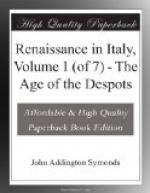In bringing this chapter on Italian Despotism in the fourteenth and fifteenth centuries to a conclusion, it will be well to cast a backward glance over the ground which has been traversed. A great internal change took place and was accomplished during this period. The free burghs which flourished in the twelfth and thirteenth centuries, gave place to tyrannies, illegal for the most part in their origin, and maintained by force. In the absence of dynastic right, violence and craft were instruments by means of which the despots founded and preserved their power. Yet the sentiments of the Italians at large were not unfavorable to the growth of principalities. On the contrary, the forces which move society, the inner instinct of the nation, and the laws of progress and development, tended year by year more surely to the consolidation of despotisms. City after city lost its faculty for self-government, until at last Florence, so long the center of political freedom, fell beneath the yoke of her merchant princes. It is difficult for the historian not to feel either a monarchical or a republican bias. Yet this internal and gradual revolution in the states of Italy may be regarded neither as a matter for exultation in the cause of sovereignty, nor for lamentation over the decay of liberty. It was but part of an inevitable process which the Italians shared, according to the peculiarities of their condition, in common with the rest of Europe.
In tracing the history of the Visconti and the Sforzas our attention has been naturally directed to the private and political vices of the despot. As a contrast to so much violence and treachery, we have studied the character of one of the best princes produced in this period. Yet it must be borne in mind that the Duke of Urbino was far less representative of his class than Francesco Sforza, and that the aims and notions of Gian Galeazzo Visconti formed the ideal to which an Italian prince of spirit, if he had the opportunity, aspired. The history of art and literature in this period belongs to another branch of the inquiry; and a separate chapter must be devoted to the consideration of political morality as theorized by the Italians at the end of these two centuries of intrigue. But having insisted on the violence and vices of the tyrants, it seemed necessary to close the review of their age by describing the Italian nobleman as court-life made him. Castiglione shows him at the very best: the darker shadows of the picture are omitted; the requirements of the most finished culture and the tone of the purest society in Italy are depicted with the elegance of a scholar and the taste of a true gentleman. The fact remains that the various influences at work in Italy during the age of the despots had rendered the conception of this ideal possible. Nowhere else in Europe could a portrait of so much dignity and sweetness, combining the courage of a soldier with the learning of a student and the accomplishments of an artist,




